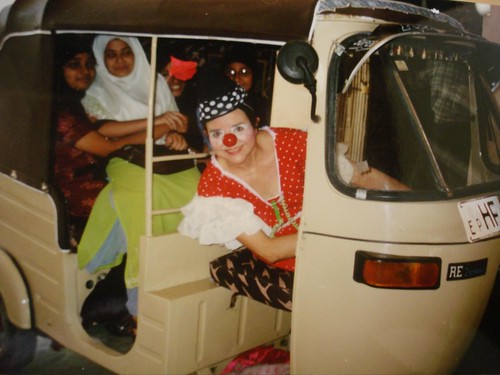
My image of South Africa before I arrived here was the township. When I pictured South Africa, I recalled images I'd seen of the Soweto uprising, the Sharpeville massacre, and the celebrations on the streets of Jo'burg's townships on the day Nelson Mandela became president of a free South Africa. That's what I thought I'd see when I got to Cape Town.
Instead, Cape Town turned out to be a resort town. Central Cape Town is beautiful, clean, and accessible. It was nice, but it felt almost too perfect, too easy. It had no edge. We knew we weren't seeing the "real" Cape Town. We saw only the tiny section of the city squished between the mountains and the ocean. This was the pretty part of town, the white part of town.
The majority of Cape Town's (non-white) residents live in the massive Cape Flats valley, far away from the stunning ocean and mountain views. That's where you'll find the
Townships. That´s the real Cape Town for most people who live here.
Townships are urban residential areas that, under apartheid, were reserved for non-whites. Legislation from the 1950's to 1980's prohibited blacks from living in the cities. Hundreds of thousands of black South Africans moved to neighborhoods outside of the large urban centers, creating squatter communities that eventually turned into highly organized mini-cities. Today, townships remain the primary neighborhoods for South Africa's urban blacks. Though apartheid is now gone, its legacy remains, and is most ...
(click to read the complete report)
Instead, Cape Town turned out to be a resort town. Central Cape Town is beautiful, clean, and accessible. It was nice, but it felt almost too perfect, too easy. It had no edge. We knew we weren't seeing the "real" Cape Town. We saw only the tiny section of the city squished between the mountains and the ocean. This was the pretty part of town, the white part of town.
The majority of Cape Town's (non-white) residents live in the massive Cape Flats valley, far away from the stunning ocean and mountain views. That's where you'll find the
Townships. That´s the real Cape Town for most people who live here.
Townships are urban residential areas that, under apartheid, were reserved for non-whites. Legislation from the 1950's to 1980's prohibited blacks from living in the cities. Hundreds of thousands of black South Africans moved to neighborhoods outside of the large urban centers, creating squatter communities that eventually turned into highly organized mini-cities. Today, townships remain the primary neighborhoods for South Africa's urban blacks. Though apartheid is now gone, its legacy remains, and is most ...
(click to read the complete report)
Photo: Hermanxs en la selva del alto Huallaga
Courtesy of Beatrice Velarde (www.beatricevelarde.com)
 Marta Sanchez, Clown without borders
Marta Sanchez, Clown without borders
No hay comentarios:
Publicar un comentario